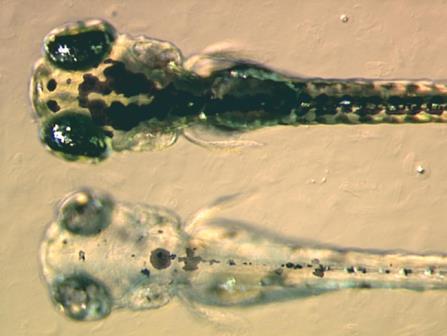Mutating Zebrafish genes gives insights into causes of human diseases
23 April 2013
Researchers have designed a method to assay the function of every Zebrafish gene to explore the effects of genetic variation. So far the team has generated one or more mutations in almost 40% of all Zebrafish genes.
The resource will be a comprehensive catalogue of how changes to our genes can have physical and biochemical consequences, giving other researchers the tools to understand human disease.
Many genes are similar between the human genome and those of less complex animals. As a vertebrate, the zebrafish (Danio rerio) has the same major organs and tissues as humans. For example, their muscle, blood, kidney and optical structures share many features with the human systems. Zebrafish embryos are transparent, so researchers can easily study their development. Zebrafish share 70% of genes with humans and 84% of genes known to be associated with human disease have a zebrafish counterpart.
“There are several advantages of the zebrafish model,” says Dr Leonard Zon, MD, Children's Hospital of Boston MA. “We can readily create variations in their genome that are relevant to human health and disease. This has allowed a greater understanding of gene function and the finding of new targets for drug treatments.
“Several small molecules discovered using the zebrafish system have recently entered into clinical trials. The availability of the genome sequence, coupled with the rapid expansion of disease models and chemical screening ability, ensures that the zebrafish system has a major place in biomedicine.”
The high-quality zebrafish reference genome sequence reported in Nature [1], has allowed the team to create different mutations in more than 10,000 genes. There are 5,494 genes known to be involved in human disease. So far, the team have identified mutations in 3,188 zebrafish gene counterparts of the 5,494 genes associated with human disease.
Based on traditional methods used to study zebrafish, the team developed a new approach to more efficiently find the consequences of genetic variation in the zebrafish. They create random mutations throughout the genome of the zebrafish and link the mutations to physical or biochemical changes.

A Zebrafish pigment mutant (unrelated to this
research). The mutant called bleached blond was produced by insertional mutagenesis. The embryos in the picture are four days
old. At the top is a wild-type embryo, below is the mutant.
The
mutant lacks black pigment in the melanocytes because it fails to
synthesise melanin properly. Source Wikimedia Commons: Bradbury J: Small Fish, Big
Science. PLoS Biol 2/5/2004:
e148.
“Our aim is to reveal the function of each gene in the zebrafish to shed light on the role of their human counterpart,” says Dr Elisabeth Busch-Nentwich, first author from the Wellcome Trust Sanger Institute. “We make these zebrafish models freely available to the wider scientific and medical communities to support their effort to understand human disease and increase the pace at which medical advancements can be made.”
A previous study at the Institute found specific mutations in the gene Titin are potential drivers for the growth of some forms of cancer. The team found that the main function of this gene in zebrafish may be associated with the division of cells in the body. This would explain why changes to this gene can affect the way cells divide and can be a driving force in the growth of cancer.
“Our zebrafish models have already been used to confirm the identity of a gene responsible for a rare disease affecting the development of bones,” says Dr Ross Kettleborough, first author from the Wellcome Trust Sanger Institute. “This is just one of many examples where this project has and will advance our understanding of human disease.”
Zebrafish have already played a central role in helping to unravel the biological processes behind muscular dystrophies and are an important model for unlocking the mechanisms of cancer and other diseases. This project will help to uncover the biological processes that underlie both common and rare diseases, point to the causal genes and may lead to new treatments.
“Our challenge is to develop a comprehensive, functional understanding of all human genes as quickly as possible,” says Dr Derek Stemple, lead author from the Wellcome Trust Sanger Institute. “Our systematic analysis of zebrafish gene function will advance understanding of human disease.”
“This is a resource that will help researchers and clinicians find the gene variations responsible for our inheritance of, and susceptibility to, diseases.”
Reference
1. Ross NW Kettleborough, Elisabeth M Busch-Nentwich, Steven A Harvey et al. A systematic genome-wide analysis of zebrafish protein-coding gene function. Advanced online publication in Nature, 17 April 2013. DOI: 10.1038/nature11992